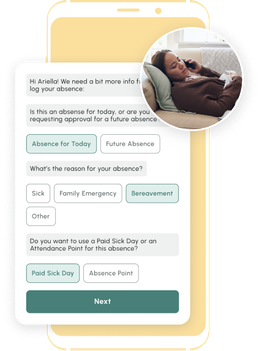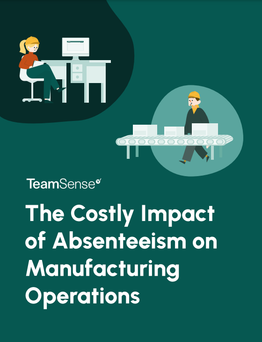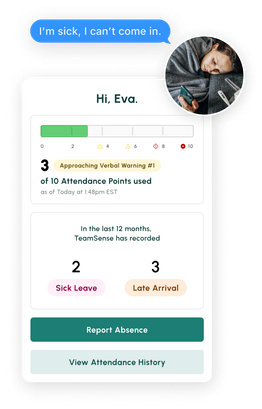Fix the root cause of No-Call No-Show with help from TeamSense
Table of Contents
Writing a warning letter for excessive absenteeism isn't a fun task (let's be honest, it's the worst!), but, it’s crucial for keeping things running smoothly and is most likely part of your company's attendance policy protocol. That being said, before you begin writing the letter, it's important to remember that you're not just ticking off a task; you're reaching out to someone who's probably already feeling the heat from their attendance issues, and it may be due to circumstances out of their control.
To tackle the challenge of employee empathy vs. company policy, when it comes to excessive absenteeism, we’ll walk you through how to draft a warning letter that’s clear, fair, and—most importantly—constructive. It’ll lay out the facts, nudge the employee towards better attendance habits, and keep that door open for support and understanding. By the end, you’ll know how to handle this tricky situation with the right mix of firmness and kindness, making sure everyone feels supported and valued. We’re here to make sure you can write a letter that gets things back on track while keeping morale high.
Understanding Excessive Absenteeism in the Workplace
Excessive employee absenteeism, is a significant problem in all work environments, regardless of industry. This is especially true with hourly employees working at manufacturing and logistics companies, where the absence of a few folks with special skills or process expertise can slow productivity and make it hard to hit the day’s targets.
It's important to understand why employees are absent and how it impacts their value to the team. Some reasons for absenteeism may be an unavoidable aspect of life, such as a death in the family or severe illness, while other reasons may be less justifiable, such as lack of disengagement or getting fed up with other employees no call no showing and getting away with it, so they start doing it too.
Company culture plays a big role in employee absences and can be attributed to demotivation and lack of engagement. When an employee feels disconnected from their work and colleagues, they're not as likely to arrive at work each day. Perhaps they're feeling undervalued or overworked, and they see no purpose in attending work every day. Employers should know that these are red flags and should take steps to prevent them by fostering a culture of accountability and transparency. Unfortunately, this is difficult in a production environment where the focus is on activity, and there are fewer channels for communication.
This can cause hourly team members to feel like a runner who loses motivation along the marathon course: when they lose sight of the finish line and feel like they are the only one running the race, it's tough for them to keep up their energy levels and push themselves forward. Organizations must make sure employees understand how their work contributes to achieving larger goals so that everyone feels like they’re working towards something meaningful.

No one wants to talk to their boss or a 1-800 stranger to call off. Text changes everything - Reducing No Call No Shows.
Initiating Conversation to Address Excessive Absenteeism
Effective communication between management and employees is key to addressing chronic absenteeism. Proactively starting a dialogue and affording workers an opportunity to explain their frequent absenteeism patterns can help avoid punitive measures. Before issuing a warning letter, a verbal warning should be given, and the following should be considered:
Data analysis can help identify absenteeism trends and inform which individuals need intervention or support from managers. For example, if most employees miss work on Fridays for doctor appointments, it may be better to schedule company medical check-ups during the week.
In another situation, after a team member misses four consecutive days of work due to illness, a manager should initiate a conversation with the employee concerned about their health condition. It would provide an opportunity to show empathy and express concern while also obtaining clarity on their expected return to work.
On the other hand, not all cases require conversations, and sometimes managers need to act decisively to address poor attendance. Cases such as violating company policy or lying about leave must be dealt with sternly using the proper channels.
Initiating conversations about frequent absences is similar to occupying cockpit seats at different times when flying an airplane. The flights' success requires collaboration between pilots on communicating about flight paths and making adjustments according to weather conditions during take-offs and landings.
Constructing an effective absence warning letter requires understanding some essential elements critical in delivering the message clearly. When drafting a warning letter for excessive absenteeism, remember that it needs to address specific points in detail while stressing concerns positively.

Constructing an Effective Warning Letter
Writing a warning letter about absenteeism is challenging, especially because employees may find the topic uncomfortable or confrontational. However, warning letters are practical communication tools, as they provide an opportunity to engage in constructive dialogue and give employees an opportunity to explain their absences or request help. The goal of an effective warning letter is to clearly articulate your expectations while maintaining fairness and providing actionable items for improving attendance.
One way to construct a warning letter is to start by providing context for the employee's behavior. Start the letter by acknowledging that the employee has missed work and the impact this has had on the company, fellow employees, and their own work progress. Do not assign blame or attack character but focus instead on providing objective information related to your concerns.
For instance, you could start the letter with something like: "I am writing to address concerns we have as a team with regard to your attendance record over the last few months. We have noticed that you have been absent frequently, and this absence has directly impacted our workflow."
After setting up context, move on to specific details about the employee's absenteeism record. This may include dates and reasons for missed shifts or days of work according to your records. Mention any other previous warnings, conversations or actions you may have taken when dealing with their absenteeism patterns. This helps maintain accountability and ensures that both parties understand what has been discussed previously.
Using data in this manner can be very persuasive in demonstrating why excessive absenteeism needs to be addressed head-on sooner rather than later.
Next, outline what you expect with regard to changes needed for improvement when addressing absenteeism issues. Be clear, and tactful, and avoid blanket statements. Be sure to state what type of absences concern you and provide guidance on how much notice should be given before taking time off. Give suggestions on how schedules can accommodate responsibilities outside work so that employees can manage their work-life balance without negatively affecting their performance or productivity.
The letter may suggest something like this: "We want to work with you to find a solution to these attendance concerns. We believe that with proper scheduling and better communication, you can strike a balance between your personal life and work demands."
It can be useful also to use an example of their actions' impact on the business, such as describing how absenteeism affects deadlines, quality, customer satisfaction, and other essential components. For example: "Your prolonged absences have forced us to reduce our ability to deliver results on time for customers, which has put us at risk of losing business we have worked hard to build.”
Providing options for support is also crucial in constructing an effective warning letter. You may always want to consider mapping out an attendance improvement plan to better set the employee up for success within the letter.
Critical Elements in an Excessive Absenteeism Warning Letter
An employee warning letter should contain critical elements to ensure clarity and effectiveness. One important element of an official written reprimand is clear language that addresses the issue objectively yet still shows empathy and concern toward the employee. This sets a positive tone for addressing absenteeism issues.
Another crucial element is explicitly defining what type of absence requires concern. It could include any form of non-emergency short-term sick leave or larger vacation requests that hamper team productivity. Highlighting examples of unacceptable absences helps the employee understand which behavior the company expects them to improve.
Use clear language like: "We consider unplanned absence from work for three days or more over a span of one-month excessive absenteeism."
The warning letter should also outline solutions for addressing the issue while providing the employee with support so they can meet your expectations for attendance. This section should include clear expectations on how often you expect them to show up and work efficiently, outlining possible alternatives like flexible start times.
It's crucial always to consider alternative solutions before imposing more stringent disciplinary measures, including termination. This not only shows concern for the employee but can also preserve any existing employment relationships while boosting morale and creating trust with staff.
Moreover, taking a positive tone towards improvement can motivate employees to appreciate their position and take ownership of their work attendance pattern,
Finally, your excessive absenteeism warning letter should conclude with clear expectations. These should include what you expect your employee to do next concerning their attendance and how you will proceed to remedy the situation if improvements are not made by the deadline provided.
For Instance, the letter could read, "We trust that you can enhance your attendance pattern over the next thirty days to avoid further consequences."
Providing feedback once an initial response is received is critical following the issuance of an absenteeism warning letter.

The Costly Impact of Absenteeism on Manufacturing Operations
Learn how chronic, unplanned absenteeism is a costly impediment to manufacturing productivity and efficiency, and how you can reduce absenteeism.
Employee Warning Letter Example
Below, you'll find an example of a warning letter that outlines specific attendance data, communicates the impact of the employee's absence on the team, and requests improvement. Throughout the official warning letter, it's vital to maintain a professional and respectful tone, ensuring that the employee understands the severity of the situation while feeling valued and heard.
Attendance Warning - Concerns and Expectations
Dear [Employee's Name], I hope this message finds you well.
This letter aims to address an issue that has become increasingly noticeable and has started impacting the dynamics of our team – absenteeism. Over the past [time period], your absences have been recorded on [specific dates], which are considered excessive by our company standards.
To clarify, an unplanned absence from work for [number] days or more over a span of one month is deemed as excessive absenteeism. Your role is integral to our team, and every absence is felt by everyone. We understand that emergencies can occur; however, it's essential to differentiate between emergencies and non-emergencies that can disrupt the workflow. We value your contribution to the team and believe that improving your attendance can further unlock your potential within our organization.
We would like to explore solutions together that could help improve your situation. For example, we could consider flexible start times or even evaluate the possibility of remote working, where applicable. Please understand, this letter is not an indictment, but this letter serves an invitation to dialogue and improvement. We trust that you can enhance your attendance pattern over the next thirty days to avoid further consequences.
Kindly consider this a formal warning regarding your absenteeism. We believe in your capabilities and your commitment to our shared goals, and we look forward to seeing a positive change in your attendance records. If you are facing any challenges that may be impacting your ability to maintain regular attendance, I encourage you to discuss them with us.
Our aim is to create an environment that is not just productive but also supportive. We look forward to your immediate attention to this matter and hope that together we can find a solution that benefits both the parties involved you and the team. We will be following up with you after thirty days to assess the situation and discuss further steps. Thank you for your understanding and cooperation in this matter.
Best regards, [Your Name]
[Your Position]
[Your Contact Information]
Follow-up Actions Post Warning Letter Issue
Once the warning letter has been issued, it is important to have a plan of action in place to follow up with the employee. The goal should be to improve attendance while also providing support and resources for the employee.
One potential follow-up action is to schedule a meeting with the employee to discuss their attendance record and any potential reasons for their absences. This can include exploring options for flexible work arrangements, discussing workplace stress or personal issues that may be affecting attendance, and addressing any questions or concerns the employee may have about the warning letter.
During this meeting, it is important to make clear that improving the employee's attendance, is essential for maintaining their role within the company. Providing specific guidance on how to improve attendance and offering resources such as counseling services or wellness programs can also help employees take steps towards better attendance.
In some cases, additional consequences may need to be put in place if the employee fails to improve their attendance after receiving a warning letter. These consequences could range from further disciplinary action or even termination of employment if continued absenteeism continues to negatively impact workflow.
Ultimately, the goal of any follow-up actions should be to address the root cause of poor employee attendance, and create a work environment that supports employee well-being and engagement. This can include implementing flexible work arrangements, providing resources for stress management or mental health support, and fostering a company culture of accountability that values open communication and transparency.
By taking a proactive approach to addressing excessive absenteeism in the workplace and following up with employees after issuing a warning letter, companies can encourage improved attendance while also promoting employee well-being and job satisfaction, and enhancing site productivity and efficiency.
Impact of Excessive Absenteeism on Workflow
The effects of excessive absenteeism are far-reaching and have lasting impacts on productivity, company culture, and financial costs. When an employee is absent, it causes a ripple effect with regard to other employees who have to pick up the slack and cover their workload. They may have to operate machinery or processes that feel unfamiliar. While this may be possible for a short amount of time, absenteeism is a constant issue - which eventually takes its toll.
When a team member is consistently absent from work, think of the absent employee as a member of a relay race team. They were tasked with the swim portion, but now the runner has to pick up the slack. Whoever's receiving the baton feels pressured and stressed having to carry more load than they're used to. Eventually, they'll burn out; even worse is if they drop the baton along the way.

Recognizing Excessive Absenteeism Patterns
Excessive absenteeism can be defined as frequently missing work without a legitimate reason, including no call no show incidents. It can impact the company in several ways and cost organizations between 20 to 30 percent of payroll expenses. However, recognizing patterns that signal excessive absenteeism often goes unnoticed by busy managers until the problem is so glaring it draws attention. It is essential to understand potential causes of further absenteeism and take proactive measures to reduce absenteeism levels before they escalate.
An example of excessive absenteeism may be when an employee consistently calls out on Mondays or Fridays. Or when they always have excuses for late arrivals, early departures, or missing consecutive days of work.
In addition, some employees may fake illness to avoid the workplace. According to a study by CareerBuilder in 2017, around 43% of employers have caught an employee lying about sick leave using social media. The data also shows that employees took leave for reasons such as shopping, traveling, or attending social events.
No call, no shows are the most disruptive form of absenteeism. When supervisors and co-workers don’t know that someone will be absent until hours into the shift, they don’t have the time to make adjustments. This harms productivity because the team can’t meet its daily targets and it harms efficiency because many sites overstaff in anticipation of no calls, no shows, or they pay excessive overtime to hit their goals. If you're having a problem with an employee who no calls no shows, you may need to write a different warning letter, one that is specifically a write-up for no call no, no-show incidents.
Regardless of the policy or process for calling off, not all absences are the same and require different responses. Managers need to identify legitimate absenteeism reasons and balance organizational needs with employee welfare. For instance, an employee struggling with mental health issues is entitled to support from their employer rather than punishment for taking sick leave.
Recognizing absenteeism patterns requires a keen eye and close observation, similar to identifying financial anomalies in accounting books. Just as red flags can indicate fraudulent activities, frequent absences can signal deeper underlying problems like poor morale, job dissatisfaction, or stress.
Understanding patterns of absenteeism is critical in initiating conversations with employees who show signs of excessive absence. Addressing these concerns in a timely fashion prevents further disruptions to workflow and helps maintain productivity levels.
- According to a report by the CDC, absenteeism costs US employers approximately $225.8 billion each year.1
- A study conducted by the Society for Human Resource Management reveals that 75% of human resources leaders believe that absenteeism has a considerable impact on their organizations' financial performance and productivity.2

Is your call-in process terrible? Text reduces no-shows and absenteeism by up to 40%.
Don't believe us? Check out this case study to see how this 3PL benefited.
About the Author

Jackie Jones, Employee Engagement & Attendance Specialist
Jackie Jones has over three years of experience helping HR teams improve employee morale, reduce absenteeism, and create happier, more engaged workplaces. With a strong background in employee relations and attendance management, she brings practical strategies and insights that support frontline teams and the HR professionals who lead them.





